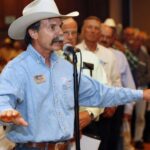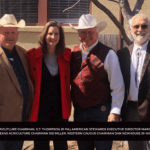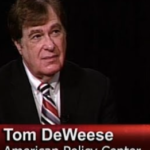
USDA Sec. Vilsack announced during the morning of Feb. 5 that NAIS was over, ended, no more.
His customary emotionless announcement was fairly brief, but the detailed USDA Factsheet (Click here for factsheet) released simultaneously required seven pages of small print describing the animal ID “will do’s” and “won’t do’s”–all of which will be enforced at some future date in a to-be-determined manner.
The New York Times reported this based on information from an “unidentified USDA informant.”
At once thousands of emails flew from around the globe with nearly as much excitement outside the US as the home land.
Ranch and cattle producers smiled and nodded.
But it seems the victory may be short lived.
Now comes a lone government employee saying he cannot endorse Sec. Vilsack’s new announcement.
Dr. W. Ron DeHaven is CEO of the American Veterinary Medical Assn. The US veterinarian head count is 100,728 licensed practitioners; of which 930 are Federal Veterinarians, employed by APHIS, and 23 are Homeland Security staff veterinarians.
DeHaven has always been a verbal supporter of mandatory NAIS. He says Vilsack “… has been caving to this public resistance…”
DeHaven’s “public resistance” is the overwhelming majority of livestock producers who opposed the NAIS for a list of reasons that would choke a giraffe.
According to DeHaven, the mag-daddy of veterinarians, none of these “resistors” should have had any voice in the NAIS’s demise, and Secretary Vilsack should not have listened to them.
One gets the feeling he would like to see Vilsack go away, and himself take control.
Then again, DeHaven has shot his mouth off before, under oath. He showed his out-of-touch thinking March 11, 2009 when he testified to the House Committee on Agriculture as a hand picked presenter. He stated, “If the US is to remain competitive or grow export markets, an effective NAIS will be required.”
Evidently unknown to DeHaven, the US has been a net importer of beef for the last 21 years. Last year, the country exported $2,183,977,168 in beef and imported $4,857,454,008.
We haven’t produced enough beef to feed the nation in 21 years, yet DeHaven confidently testified that future exports are imperative.
USDA released their NAIS Fact Sheet February 5. It states:
“What is certain is that animal disease traceability will be required for animals moving in interstate commerce. . .To ensure interstate compatibility and connectivity, APHIS will work with States and Tribal Nations in establishing standards and guidelines where free or low-cost tags will be incorporated as options.”
DeHaven says the AVMA cannot endorse the Vilsack new approach:
“As I understand it, they will let each state and tribal nation more or less develop their own program? So, I’m concerned about interoperability between fifty or more different systems. Will one state be able to talk to another state as an animal moves through interstate commerce?”
DeHaven’s Audio: “Click Here”
From this statement, it would appear DeHaven has never processed an interstate veterinarian animal health certificate.
Here is how it works, and has for every veterinarian’s lifetime:
- An animal is sold into another state.
- The state receiving the animal has “states rights” and determines the rules of entry.
- The owner of the sold animal contacts their local veterinarian.
- The vet has an “Entry Permit Acquisition Book” with phone numbers of every US state and tribe, provided by the USDA.
- They call the state vet office of destination, talk to an authorized person, receive the required protocol, do what ever health tests are required for entry, complete a standard animal health certificate, receive a permit number to enter the state, and the critter is ready to travel.
This health certificate has four copies of different colors.
- One copy goes with the hauler,
- One stays with the local vet,
- Two go to the state vet of origin, and
- They forward one copy on to the receiving state vet.
The receiving state has a staff of people who check these incoming certificates every day, and may actually go and inspect the animals after arrival if they have concern.
It has always been required that a permanent ID be on each departing critter. This can be a:
- Fire brand number,
- Tattoo,
- Cheap government metal ear clip,
- OCV clip, or
- Other approved ID.
This has been established and is already done.
No animals travel across state lines without ID and a health certificate, and nothing is new about that.
This is a system that has worked for a lifetime, and Vilsack understands the total cost to USDA is zero to continue this process.
This system has been used successfully during every major outbreak of livestock disease in our history.
Currently a huge weight of mistrust hangs over DeHaven, Vilsack, and the USDA. Vilsack says he is well aware of “. . .the downward confidence level NAIS has caused.”
The attempt to shove NAIS down the throat of every livestock producer in the U.S. will-not-be-forgotten, and the USDA may try to resurrect and rename it again–the Every Animal Traceability Tax, (EATT), or the No Cow Left Behind (NCLB)–but the results will be the same.
And another bureaucrat like DeHaven will stand up before some Congressional committee and pretend there is this huge, dangerous, animal disease mountain to climb and that without a NAIS, the food safety of the nation will be imperiled.
Hopefully, that bureaucrat will have enough sense to know we already have a successful interstate commerce system in place, and that all it takes for a producer to comply is to make a phone call to the destination state and do what the receiving state asks.
It’s that simple.



